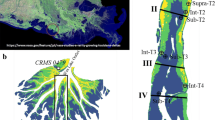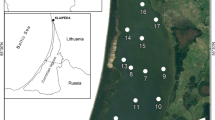Abstract
In situ measurements of the exchange of ammonia, nitrate plus nitrite, phosphate, and dissolved organic phosphorus between sediments and the overlying water column were made in a shallow coastal lagoon on the ocean coast of Rhode Island, U.S.A. The release of ammonia from mud sediments in the dark (20–440 μmol per m2 per h) averaged ten times higher than from a sandy tidal flat (0–60 μmol per m2 per h), and while mud sediments also released nitrate and phosphate, sandy sediments took up these nutrients. Fluxes of nutrients from mud sediments, but not from sandy areas, markedly increased with temperature. Ammonia release rates for mud sediments in the light (0–350 μmol per m2 per h) were lower than those in the dark and it is estimated that some 25% of the ammonia released to the water column on an annual basis may be intercepted by the benthic microfloral community. Estimates of the annual net exchange of nutrients across the sediment-water interface, weighted by sediment type for the lagoon as a whole, showed a release of 450 mmol per m2 of ammonia, 5 mmol per m2 of phosphate, 5 mmol per m2 of dissolved organic phosphorus, and an uptake of 80 mmol per m2 of nitrate. Although rates of ammonia and nitrate exchange were comparable to those described for the deeper heterotrophic bottom communities of nearby Narragansett Bay, rates of benthic phosphate release were significantly lower. On an annual basis the Bay benthos released approximately 20 times more inorganic phosphate per unit area than did the lagoon benthos. As a result., the N/P ratio for the flux from the sediments was 74∶1 in the lagoon, compared with 16∶1 in “average” marine plankton and 8∶1 for the benthic flux from Narragansett Bay. The lack of remineralized phosphate in the lagoon, is reflected in water, column phosphate concentrations (always <1 μm) and water column N/P ratios (annual N/P=27) and suggests that the lagoon may show phosphate limitation rather than the nitrogen limitation commonly associated with marine systems.
Similar content being viewed by others
Literature Cited
Boynton, W. R., W. M. Kemp, and C. G. Osborne. 1980. Nutrient fluxes across the sediment-water interface in the turbid zone of a coastal plain estuary, p. 93–109. In V. S. Kennedy (ed.), Estuarine Perspectives. Academic Press, New York.
Brady-Campbell, M. M., D. B. Campbell, and M. M. Harlin. 1984. Productivity of Laminaria spp. near the southern limit in the northwestern Atlantic Ocean. Mar. Ecol. Prog. Series 18:79–88.
Cromwell, J. E. 1971. Barrier coast distribution: a world-wide survey. Abstr. Vol., Second Natl. Coastal and Shallow Water Research Conf. 50:408.
Dietz, C. G. 1982. Ammonium fluxes from estuarine sediments: Great South Bay, New York. M.S. Thesis, State Univ. of New York, Stony Brook.
Dugdale, R. C., and J. Goering. 1967. Uptake of new and regenerated forms of nitrogen in primary productivity. Limnol. Oceanogr. 12:196–206.
Froelich, P. N., and M. E. Q. Pilson. 1978. Systematic absorbance errors with Technicon Autoanalyzer II colorimeters. Water Res. 12:599–603.
Furnas, M. J., G. L. Hitchcock, and T. J. Smayda. 1976. Nutrient-phytoplankton relationships in Narragansett Bay during the 1974 summer bloom, p. 118–134. In M. L. Wiley (ed.), Estuarine Processes: Uses, Stresses and Adaptation to the Estuary, Vol. 1. Academic Press, New York.
Grace, J., and W. Kelley. 1981. Fresh Water Input to R.I. Coastal Ponds. Report prepared for the Coastal Resources Center, URI, Kingston, Rhode Island. 16 p.
Kelly, J. R., and S. W. Nixon. 1984. Experimental studies of the effect of organic deposition on the metabolism of a coastal marine bottom community. Mar. Ecol. Prog. Series 17:157–169.
Lambert, C. E., and C. A. Oviatt (eds.). 1983. Manual of Biological and Geochemical Techniques in Coastal Areas. URI Mar. Tech. Rep. No. 86.
Menzel, D. W., and N. Corwin. 1965. The measurement of total phosphorus in seawater based on the liberation of organically bound fractions by persulfate oxidation. Limnol. Oceanogr. 10:280–282.
Nixon, S. W. 1981. Remineralization and nutrient cycling in coastal marine ecosystems, p. 111–138. In B. J. Neilson and L. E. Cronin (eds.), Estuaries and Nutrients. Humana Press, Clifton, New Jersey.
Nixon, S. W. 1982. Nutrient dynamics, primary production and fisheries yields of lagoons. Oceanologica Acta European J. of Oceanogr. Proceedings Symp. SCOR-IABO-UNESCO, Bordeaux, France, 8–14 Sept. 1981, p. 357–371.
Nixon, S. W., B. N. Furnas, R. Chinman, S. Granger, and S. Heffernan. 1982. Nutrient inputs to Rhode Island coastal lagoons and salt ponds. Final report to R. I. Office of Statewide Planning, University of Rhode Island, Kingston, Rhode Island.
Nixon, S. W., J. R. Kelly, B. N. Furnas, C. A. Oviatt, and S. S. Hale. 1980. Phosphorus regeneration and the metabolism of coastal bottom communities, p. 219–242. In K. R. Tenore and B. C. Coull (eds.), Marine Benthic Dynamics. University of South Carolina Press, Columbia, South Carolina.
Nixon, S. W., C. A. Oviatt, and S. S. Hale. 1976. Nitrogen regeneration and the metabolism of coastal marine bottom communities, p. 269–283. In J. M. Anderson and A. Macfadyen (eds.), The Role of Terrestrial and Aquatic Organisms in Decomposition Processes. Blackwell Scientific Publications, London.
Nowicki, B. L., and S. W. Nixon. 1985. Benthic community metabolism in a coastal lagoon ecosystem. Mar. Ecol. Prog. Series 22:21–30.
Solorzano, L. 1969. Determination of ammonia in natural waters by the phenolhypochlorite method. Limnol. Oceanogr. 14:799–801.
Strickland, J. D. H., and T. R. Parsons. 1968. A practical handbook of seawater analysis. Bull. Fish. Res. Board Can. 167:1–310.
Technicon Industrial Systems. 1973. Industrial methods for Technicon Autoanalyzer.
Wood, E. D., F. A. J. Armstrong, and F. A. Richards. 1967. Determination of nitrate in seawater by cadmium-copper reduction to nitrite. J. Mar. Biol. Assoc. U.K. 47:23.
Zeitzschel, B. F. 1980. Sediment-water interactions in nutrient dynamics, p. 195–212. In K. R. Tenore and B. C. Coull (eds.), Marine Benthic Dynamics. University of South Carolina Press, Columbia, South Carolina.
Author information
Authors and Affiliations
Additional information
This paper was presented at a session convened by Edward J. Carpenter and Virginia Lee at the Seventh Biennial Conference of the Estuarine Research Federation, October 22–26, 1983, Virginia Beach, Virginia.
Rights and permissions
About this article
Cite this article
Nowicki, B.L., Nixon, S.W. Benthic nutrient remineralization in a coastal lagoon ecosystem. Estuaries 8, 182–190 (1985). https://doi.org/10.2307/1352199
Received:
Accepted:
Issue Date:
DOI: https://doi.org/10.2307/1352199




